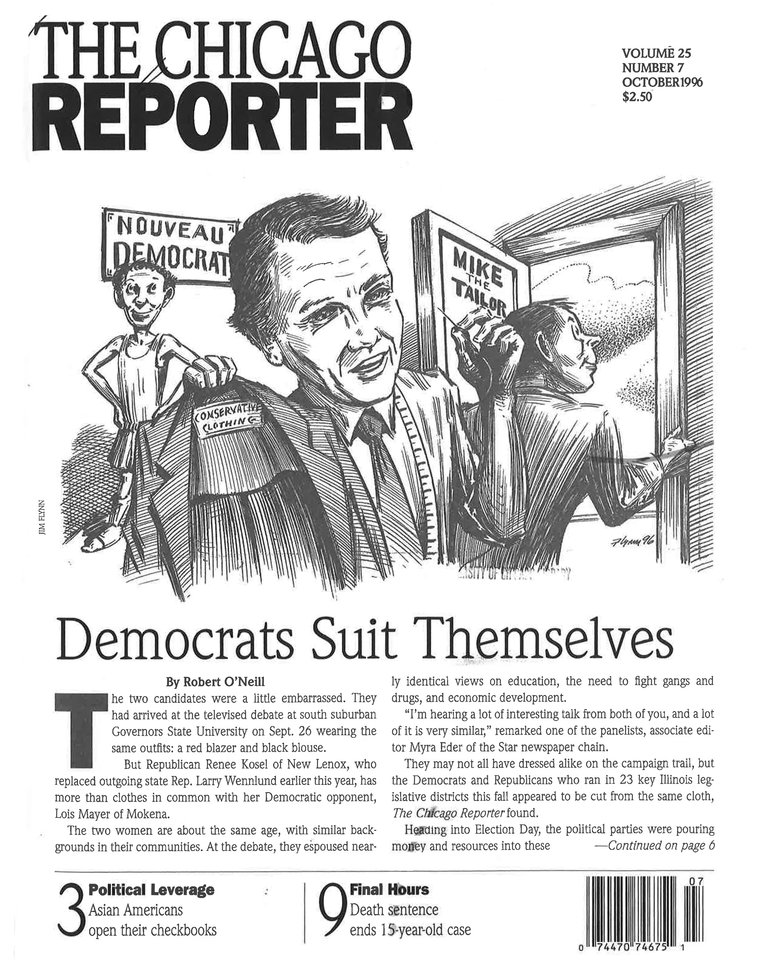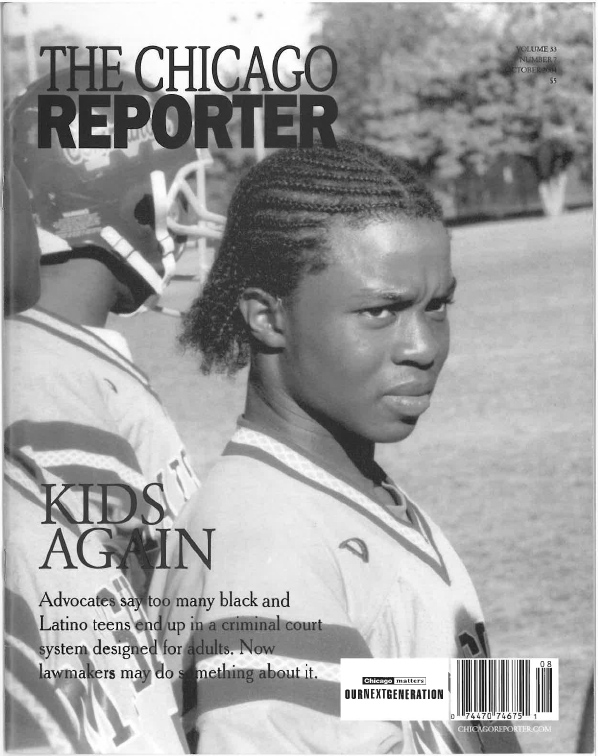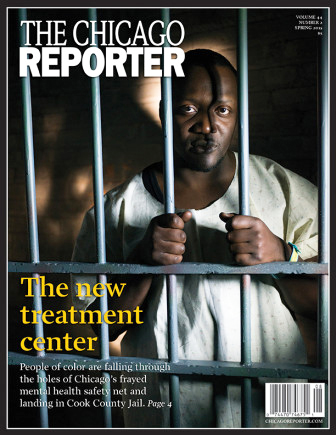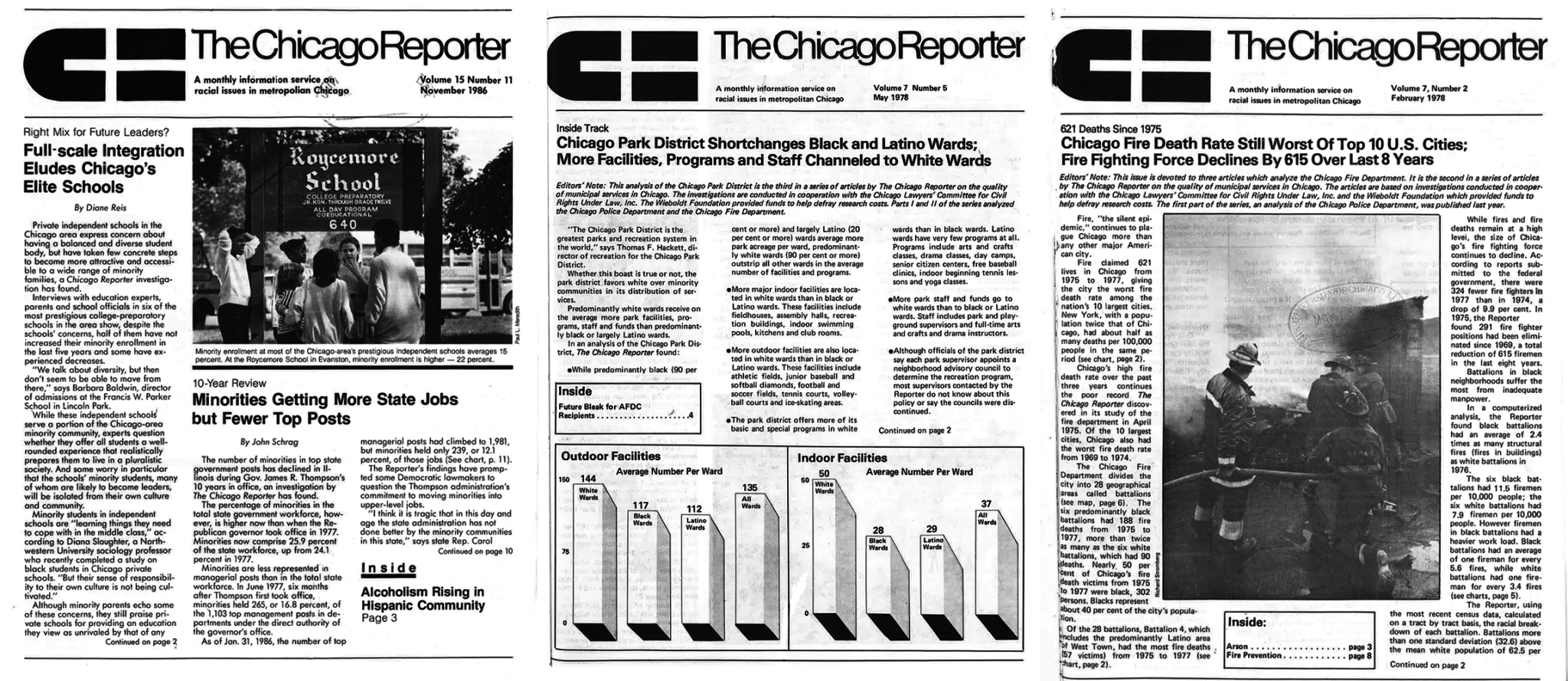After the editor’s note was posted to the website, after the announcements on Facebook and Twitter, after the letters were sent to subscribers, Susan Smith Richardson received a phone call. Richardson, the editor and publisher of The Chicago Reporter, had received several phone calls since announcing on September 4 that the Reporter, which has covered the intersection of race, policy, and economic inequality in Chicago since 1972, would be going online only, but she had been expecting one like this.
I’m sorry it’s going away, the caller, an eighty-some-year-old Reporter subscriber from South Shore, told Richardson, because I’m not online. The caller told Richardson that she was once a community activist herself, devoted to the issues the Reporter covers.
Richardson used a lot of adjectives to describe the conversation: “lovely,” “long,” “pleasant,” “meaningful”—in all, “one of the most important phone calls I got after going digital,” she said. It was also the only such conversation she had—so far, the woman from South Shore has been the only person to call to express disappointment with the decision.
Richardson had been expecting a flood of calls like this, but it never came. In a digital era when leaving the print medium may still be interpreted as surrender, the support for discontinuing its print publication has been vindicating for the Reporter. Richardson has seen the bold move confirmed as the right decision.
Ever since civil rights activist John McDermott founded a slim newsletter called The Chicago Reporter in 1972, it has been unique. No other news organization—then or now—focuses solely on investigating race, poverty, and economic inequality in a specific city. (Tom Brune, a former Reporter managing editor who is now working on a master’s thesis on its history, says he has yet to find “anything quite like it.”) The Reporter has been alarmingly consistent in this respect, to the point that past Reporter stories, whether about gentrification in Lincoln Park or racial diversity in enrollment and faculty at Chicago-area universities, feel like they could have been published in the last couple of years rather than deacdes ago. Its investigations have consistently won awards and influenced policy: among the standouts are a 1978 story about discrepancies between park facilities in white, black, and Latino wards that spurred a three-year investigation by the U.S. Department of Justice, and a 2000s series on mortgage lending practices that was integral to the Illinois Attorney General’s lawsuits against two lending firms. There has never been any confusion about the work the Reporter does, only over what the Reporter is.
For one, it’s under the umbrella of the Community Renewal Society (CRS), a social justice organization with a faith-based lens. Though the Reporter maintains editorial independence from CRS and is not involved with the nonprofit’s organizing and policy work, Richardson said the CRS covers the Reporter’s operating costs.
Although it started out as what the New York Times once called a “gadfly newsletter,” the Reporter quickly morphed into a monthly investigative publication, usually eight pages: in the seventies and eighties, a subtitle next to its blocky logo explained in small print that it was “a monthly information service on racial issues in metropolitan Chicago.” As it grew in size to twelve to sixteen pages in the eighties and nineties and twenty to thirty pages in the 2000s, acquiring the trappings of a magazine along the way (a graphically designed cover, regular columns, less perfunctory photos), its label became malleable, wavering between words like “periodical” and “magazine” and, most generally, “publication.” Richardson now defines it as a “nonprofit investigative news organization.”
“We’re a news organization,” she says. “Period.”
“ ‘News organization’ opens up a lot more possibilities,” former Reporter editor Laura Washington explains. Washington first joined the Reporter as an intern in 1979, edited it in the nineties, filled in as its interim publisher in late 2012 and 2013, and led the search for its new editor and publisher, who ended up being Richardson. When interviewing candidates, Washington always brought up the Reporter’s online presence, and as interim publisher, she tried to frame the Reporter as a multimedia news organization.
“That’s where the media world is right now,” Washington says. “To think about it as a publication was too limiting and too parochial.”
Richardson knew the editor job would come with the task of creating a stronger online presence, whatever that might be. But it wasn’t until August 2014, after she had served as editor for nearly a year, that the question took on a new dimension: in Ferguson, Missouri, Michael Brown was shot by a police officer while unarmed, and the racial justice issues that the Reporter had been writing about for over forty years once again rose to the forefront of the national conversation that ensued. How could the Reporter get in the middle of it?
“Issues around policing, Black Lives Matter, and so many other racial justice movements had erupted through these incredible online conversations,” Richardson recalls. “A lot of the core issues we had reported about were really playing out, and the ideas being spread were clearly via social media. It struck me that, well, we need to think about how we can be in those conversations more aggressively with the type of information and investigative work that we do, and the data. We really wanted to inject into those conversations knowledge and information, and that meant we had to up our digital game. That increasingly led me to believe that we don’t need to think about how we can keep so many issues of the magazine—we need to just go fully digital. That’s where things are happening, that’s where we can certainly have the most impact in terms of the type of work we’re doing, and that’s also where the audiences are.”
For every eighty-year-old in South Shore who’s not online, there are far more Chicagoans who get their news on desktops at work, on their phones while on the train, on Facebook or on Twitter. Richardson knows this—a sleek website redesign launched this past January, and she hired the Reporter’s first-ever social media editor, Asraa Mustufa, in March. When Mustufa first arrived, she was greeted by such a small staff—just five other full-time employees—that she remembers asking herself why they were hiring a social media editor over another reporter.
Now, however, she understands. It pays off, Mustufa says, “in branding, getting our articles out there, engaging more people.”
“We do this because we want to communicate information,” Richardson says. “My question is always how can we get what we do to people who could get value from it, whose lives could be made better by the type of work we do.”
 The problem wasn’t necessarily that the print magazine was failing at this task—it was that a host of evidence, like the roots of “Black Lives Matter” in a hashtag, showed that digital media could do it better.
The problem wasn’t necessarily that the print magazine was failing at this task—it was that a host of evidence, like the roots of “Black Lives Matter” in a hashtag, showed that digital media could do it better.
For a small organization with limited resources, it came down to another urgent concern: practicality.
“You want to put yourself in the best position to have an impact,” Richardson says. “We could no longer be spread thin between trying to figure out how to do a quarterly magazine and being more nimble and in lockstep with events online. We had to make a choice.”
The practical subject Richardson elides here is money. Although the Community Renewal Society covers the Reporter’s operating costs, it’s Richardson’s job as editor and publisher to fundraise the program budget through donations and grants, a job that never really ends; there are always more grants to apply for, and grants to maintain. Over the years, the Reporter has consistently been supported by a few private foundations.
The Reporter has always been small in both staff and circulation, which has never been ideal for financial comfort. “We have made it a top goal in 1979 to try to increase our income so that we can move from a predominantly part-time to a predominantly full-time reporting staff,” former editor John McDermott wrote in his year-end letter in 1978. This declaration came after a note on the changes to the Reporter’s masthead, a practice that’s since turned out to be one of the masthead’s consistent features: it’s always rotating, and there are always friendly editor’s notes pointing out the rotations. Even now, only one name on the Reporter’s current masthead dates as far back as mid-2013.
“One of the things that’s part of the Reporter’s mission is training journalists in our brand,” Washington says, casting a better spin on the revolving door. “The focus on data and the focus on hard news reporting, the focus on race. Folks come through the Reporter, they stay for a while, some longer than others. They move on to other news organizations, and we like to think they bring that ethic and that value with them.”
She’s not wrong: Angela Caputo, a former staff reporter who became an investigative reporter at the Tribune a year ago, still does the data-driven journalism that she learned at the Reporter, but now with better resources. Her first Tribune investigation found that the Chicago Police Department’s DUI checkpoints are concentrated in African-American and Latino neighborhoods, a story that would have been at home in the Reporter. But at a journalism workshop on the South Side three weeks ago (hosted by the Weekly and other organizations), she noted that the mapping software she used at the Reporter was cheaper than what’s now available to her at the Tribune.
Although the Reporter is better off now than in 2005, when, amid financial and editorial troubles, it switched from a monthly to a bimonthly publishing schedule, this last year still saw it downsize even further, to a quarterly. As its format has continuously mutated, possibly the only design feature that’s remained the same since 1972 is a phrase that can often be found at the bottom of the Reporter’s infographics: “analyzed by The Chicago Reporter.” This one feature shows how the Reporter’s work has been the same for the past forty-three years, as have its methods: investigative journalism sculpted from lots of messy data.
I think data analysis has always been the core of what the Reporter’s about,” said Jeff Kelly Lowenstein, a former staff reporter and data journalist.
If data-driven journalism is at the heart of the Reporter’s mission, then going online only means allowing the Reporter to fine-tune what it’s always done best. The resources that were once devoted to the print publication will now, Richardson says, be directed to the expanded multimedia opportunities promised by the digital world, particularly data visualization.
Nowadays, when data journalism is mentioned, the term “data visualization” isn’t far behind, referring to the presentation of data in the pictures and graphics that are integral to the articles they accompany. When these graphics are online, they can be interactive. As hot as interactive data visualization may be right now, it’s really the Reporter’s rightful inheritance, a much-needed upgrade to those decades of infographics.
“One of the things that frustrated me back in the day as a reporter and editor was so much content ended up on the cutting room floor,” Washington said. “Now in the digital world you can do a lot of work—you can present a lot of data online that you couldn’t do in a publication. You can expand and enrich that investigative reporting that is the foundation of the publication.”
Richardson plans to hire a data editor by the beginning of 2016, an addition long overdue.
“It’ll allow us to do more and better data analysis and data visualization and be more creative in how we do that,” says Jonah Newman, the Reporter’s database reporter. “In a small publication, manpower is always the thing that we have the least of, right, we’ve got a lot of energy and enthusiasm, but there’s only so much you can do with all that.”
“It’s a really good idea,” said Lowenstein of the new position—and one he thinks the Reporter needs. When Lowenstein cruised through the Reporter’s recent stories a couple weeks ago to take a look at their infographics, his reticence said more than his words. “They’re trying, but I think there’s a lot of room there,” he said finally. For example, he wondered why a story on driving while black in Chicago incorporated no data visualization.
 Richardson views multimedia and data visualization work as a “new way of presenting and giving people information that hopefully they can use to act on transforming their lives.” But while the rhetoric of revelation is easy and feels good to say, the execution is the hard part. Since it’s only been a couple of months since the transition to online-only, and the data editor isn’t even on board yet, it’s too much to expect a noticeable improvement in the graphics accompanying the Reporter’s recent articles.
Richardson views multimedia and data visualization work as a “new way of presenting and giving people information that hopefully they can use to act on transforming their lives.” But while the rhetoric of revelation is easy and feels good to say, the execution is the hard part. Since it’s only been a couple of months since the transition to online-only, and the data editor isn’t even on board yet, it’s too much to expect a noticeable improvement in the graphics accompanying the Reporter’s recent articles.
“We’ve always had that mentality of how can we present things online differently versus in print, so that won’t change,” Newman said. “The possibilities of online data visualization are changing all the time. So there’s an opportunity to improve and expand our online presentation, but I don’t think being online-only really affects that very much.”
“From my standpoint, it’s the same story either way,” Newman added. “I still have to write the story, I still have to report it, I still have to do the data analysis—that doesn’t change.”
A lot about the Reporter won’t be changing. Richardson still plans to run three to four major investigations a year, like the Reporter did in print, and although she hopes to hire a full-time multimedia producer to oversee video and audio, multimedia is not new to the organization. And the publication will still appear in print once a year, collecting the articles deemed the “best of” each year, a nod both to its print legacy and to the older subscribers who formed the backbone of the community that grew up around the Reporter. Richardson even intends for the annual to have some new content, like essays and book reviews. There’s still room, in this brave new world, for the former community activists in South Shore. That’s the point of an online-only Chicago Reporter: there’s more room.
“The Reporter was very much a niche publication, where it kind of had its crowd and that was it,” says Mustufa, who came to the Reporter from Colorlines, a national news site focusing on racial justice. Mustufa says Richardson hired her not because she was especially social media-savvy but because she understood the Reporter’s journalistic mission and its national potential. Chicago, according to both Mustufa and Richardson, is a “national story.” A lot has changed since 2005, when a Chicago Reader article by Michael Miner ascribed its financial trouble to the fact that “race and poverty stopped being topical, and the major media lost interest in the Reporter’s findings.” Now, says Mustufa, as Richardson noticed during the initial protests in Ferguson, the Reporter has the opposite problem: “There is such an interest in race, policing, things the Reporter has been doing for years. It’s almost crowded space. But it is such an opportunity in the national climate.”
“It’s a little overwhelming,” she added, “trying to stand out and produce really unique, compelling content.”
The content the Reporter does have, though, is getting out there. In the eight months since Mustufa came on board, the Reporter’s Facebook likes, which had been increasing at a rate of 1,000 a year for the past four years, have since nearly doubled, from 5,000 to 9,800 as of press time. Its Twitter followers currently number about 17,500, and Twitter users’ engagement with the Reporter’s account has quadrupled since March, even if the Reporter’s tweets can sometimes be a bit too hashtag-happy. The Reporter’s reach may not match that of news website DNAinfo Chicago, which has about 66,000 Facebook likes and 39,700 Twitter followers, but the Reporter can’t be like DNAinfo, “constantly spitting out articles,” as Mustufa put it.
Although the Reporter now has shorter weekly investigations of around eight hundred to a thousand words, Richardson is firm on what they won’t add: no breaking news, no stories every day.
“That would be asking for us to produce crap, essentially,” she says. “We’re really not going to turn ourselves into something we don’t have the potential to be.”
So far, Richardson has followed through—the Reporter isn’t publishing articles every day, and the articles they do publish aren’t crap, to say the least. The front page of its website last week displayed an array of multimedia pieces: a photo gallery of political graffiti, a blog post about policing, a video about a 106-year-old Englewood resident, and longer pieces covering classic Reporter subjects such as immigration and housing.
One piece at the bottom of the page, published November 11, was written by Newman, who has some experience in education reporting, and titled “No quick fix to racial gaps in higher ed.” It’s the sort of quick, data-driven investigation Richardson envisioned, accompanied by a clean, multicolored—though not noticeably innovative—graph showing the six-year graduation rate for students at four-year colleges, sorted by race. It’s informative and well-written. And it was produced in just a couple of days, in response to the resignation of the president of the University of Missouri after students protested his lack of attention to discrimination faced by black students. Chicago comes up not once in the article.
“Given Mizzou’s proximity to Chicago and the important national story that was going on, it didn’t necessarily need to have a strong Chicago focus,” Newman said.
 Although the issues discussed in the article are certainly relevant to Chicago-area schools, it was a slightly unexpected application of Richardson’s desire to “cover Chicago in a broad context and in a deep way that creates the national story that the city already has the potential to be.” The lesson in the Mizzou article is directed toward Chicago, not by Chicago. It’s a national story, but the article doesn’t do the explicit work of describing how it’s a Chicago story, and it’s surprising that there are no specific references to racial representation and graduation rates at the many universities and colleges in Chicago.
Although the issues discussed in the article are certainly relevant to Chicago-area schools, it was a slightly unexpected application of Richardson’s desire to “cover Chicago in a broad context and in a deep way that creates the national story that the city already has the potential to be.” The lesson in the Mizzou article is directed toward Chicago, not by Chicago. It’s a national story, but the article doesn’t do the explicit work of describing how it’s a Chicago story, and it’s surprising that there are no specific references to racial representation and graduation rates at the many universities and colleges in Chicago.
“Some stories should be covered, even if they are not in Chicago,” Richardson said. “Mizzou is a good example of a national story that needed to be addressed: it’s in the Midwest, but it also inspired solidarity actions on Chicago-area campuses. We are mindful about documenting what I think is an emerging new civil rights movement that is youth-led…. As an organization that covers racial inequality, our role is to bring historical and other context to these issues.” Going forward, Richardson said the editorial team will discuss and choose when to write stories not based right in their backyard: “We will remain Chicago-focused, but not close the door to considering stories that are not local if we think there is value locally.”
On November 18, the Reporter received a $500,000 two-year grant from one of its longtime supporters, the MacArthur Foundation—the largest single grant the Reporter has ever received. The press release states the funds, “a significant investment in the Reporter’s growth and development at a time when race has reemerged as a central issue in public policy,” will go towards expanding staff and exploring partnerships with other news organizations. Less officially, the grant is an expression of confidence that the Reporter belongs in the middle of the resurgent national conversation about race and inequality. If Chicago is a national story, if race and inequality are a national conversation, then The Chicago Reporter should have national reach.
When the Reporter started up shortly after the civil rights movement’s heyday, the publication conceptualized itself locally, even though it deemed its subjects universal. “Race touches everybody and everything,” McDermott wrote in an editorial in the newsletter’s debut in 1972. “Racial peace and progress…are matters of profound self-interest to every person and institution in this community.” Yet McDermott’s 1978 end-of-year letter casts its accomplishments in a Chicago-centric light, concluding that “the Reporter has come to play a seminal role in Chicago in creating a deeper understanding of our community’s number one social challenge.”
In the digital age, geographically bound hierarchies no longer apply, and the tension between the Reporter’s local focus and national interest is more evident than ever before. So how can the Reporter play a national role and remain community-focused? How can an organization that took the space to note when a staff reporter won an award redefine its community to include whomever likes its tweets and shares its Facebook posts? These are the questions the organization must grapple with as it moves into a new era.
“It’s really hard to figure out how to hold on to its core social mission and its importance and legacy in this town while also figuring out how to move that into the future,” Richardson said.
Perhaps the best way for the Reporter to write for a national audience is to be what it always has been—The Chicago Reporter, the organization devoted to the city whose racial inequality no one else has ever covered in such gimlet-eyed depth. As its fluctuation over the years in length, design, and now medium demonstrates, that doesn’t mean staying static in form, just staying true to its home city. The MacArthur grant is big; if it works, if a nation tunes in, the Reporter will move into the future by staying right here.


